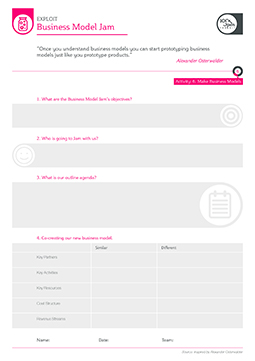Business Model Jam
“Once you understand business models you can then start prototyping business models just like you prototype products.”Alexander Osterwalder


The Business Model Jam is a workshop designed to collaboratively build a business model that will make profit from our innovation by creating value for its users.
This tool is a ‘how to’ that ensures a collaborative style of workshop where the open innovators create and agree on a business model. Ideally this builds on an Investable Proposition that has been previously agreed.

All Jam workshops depend on three main ingredients:
In advance of the Jam we need to agree with our fellow jammers what we are going to achieve and why. For example are we committed to our current business model? What is the case for change? Do we have a new Investable Proposition to test? What level of detail does our business model need? Could we prototype different models in the Jam? What happens afterwards?
We invite senior representatives from the Challenge Holder and innovation partner organisations. We should consider including people from the commercial, marketing, market research, production and design and finance teams. For developing new business models, it is important to have both creative and analytical thinkers.
Here is a typical agenda of a Business Model Jam to develop one business model. Alternatively we might focus on prototyping different business models (See Business Model Canvas for more details). For a successful Jam we need to start acting collaboratively to get into a collaborative mindset. There are a number of suitable group warm-up exercises such as co-drawing and constellations in Co-creation Techniques.
The key output for this Jam is one or more new Business Model Canvases. This is a tool is for creating a distinctive business model around our innovation or organisation.
0900: Welcome, presentation/agreement of the Jam objectives and if appropriate a demonstration of the innovation and its outline business case or Investable Proposition Template
0930: Collaboration mindset – warm up exercises (See Co-creation Techniques)
1000: SWOT the current business model or new Investable Propositions in groups and present back
1100: Break
1130: Presentation of the Business Model Canvas tool with examples
1200: Analyse competitive products or services in groups using the section 4 of the form
1230: A well-earned lunch
1330: In breakout groups agree which two or three sections of the canvas to prioritise and develop those sections or alternatively agree to develop several new models in separate groups
1430: Present back in plenary with open questions. Dot vote on the best canvas
1530: Convene expert groups to develop different parts of the winning canvas in parallel and analyse using section 4 of the form
1630: Present back and build on comments
1730: Close
4. Co-creating our new business model
We use this table to record how distinctive our new Business Model Canvas is compared to our previous one or compared to our competitors.
First we learn about the Business Model Canvas by choosing five or six competitors of our product, service or brand to serve as examples and analyse their business models using the Canvas. We can then use this analysis to create a distinctive business model for our innovation.
We copy the table in Section 4 of the form to analyse the norms and outliers in our sector, filling in one copy of the table per competitor. What are the similarities in business model across our sector? What are the points of difference between business models in our sector?
| Similar | Different | |
|---|---|---|
| Key Partners | ||
| Key Activities | ||
| Key Resources | ||
| Cost Structure | ||
| Revenue Streams |
As this is open innovation 100%Open has prioritised the parts of the Business Model Canvas that are most relevant to effective partnerships: Key partners, Key Activities, Key Resources, Cost Structure and Revenue Streams.
After we have co-created our new Business Model Canvases, we repeat the above exercise using the same table to evaluate whether our Jam has produced a viable and distinctive model. What aspects of the Business Model Canvas are similar and what aspects are different to others in our sector? Are the similarities and differences beneficial?
Source: Inspired by Alexander Osterwalder
You must be logged in to download this tool
You must be logged in to download this worked example
2014 - 100%OPEN LTD